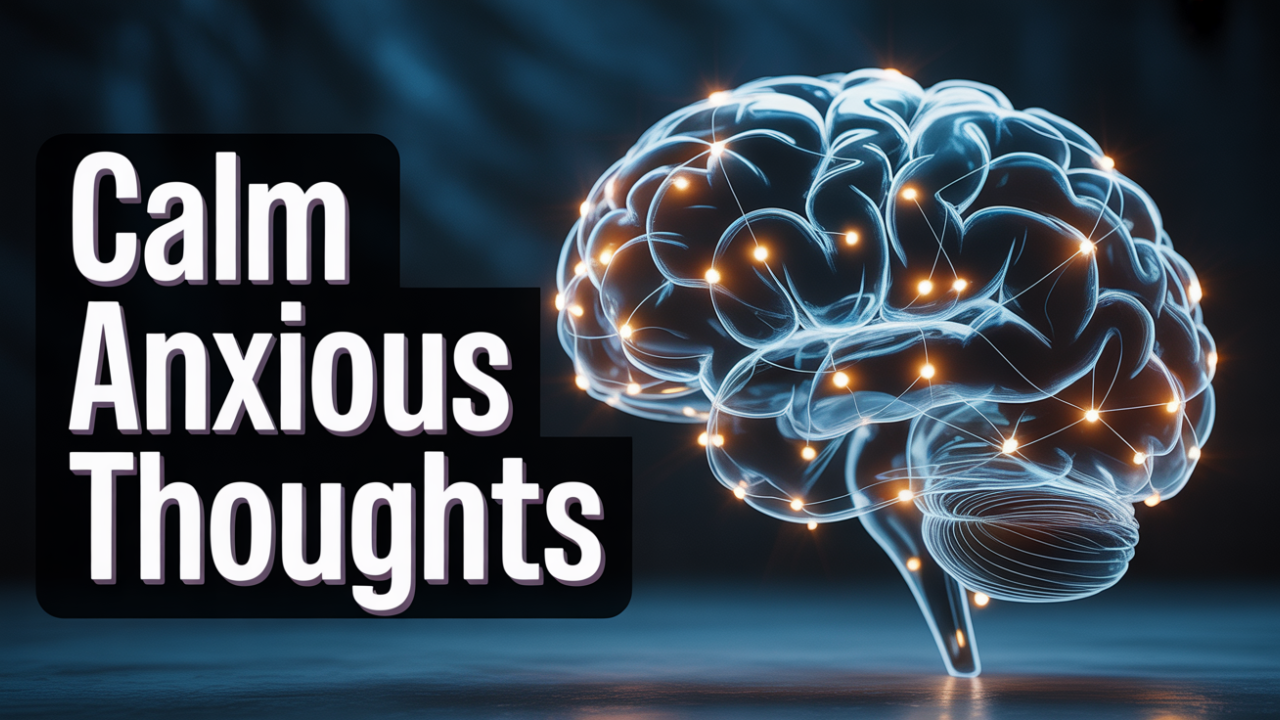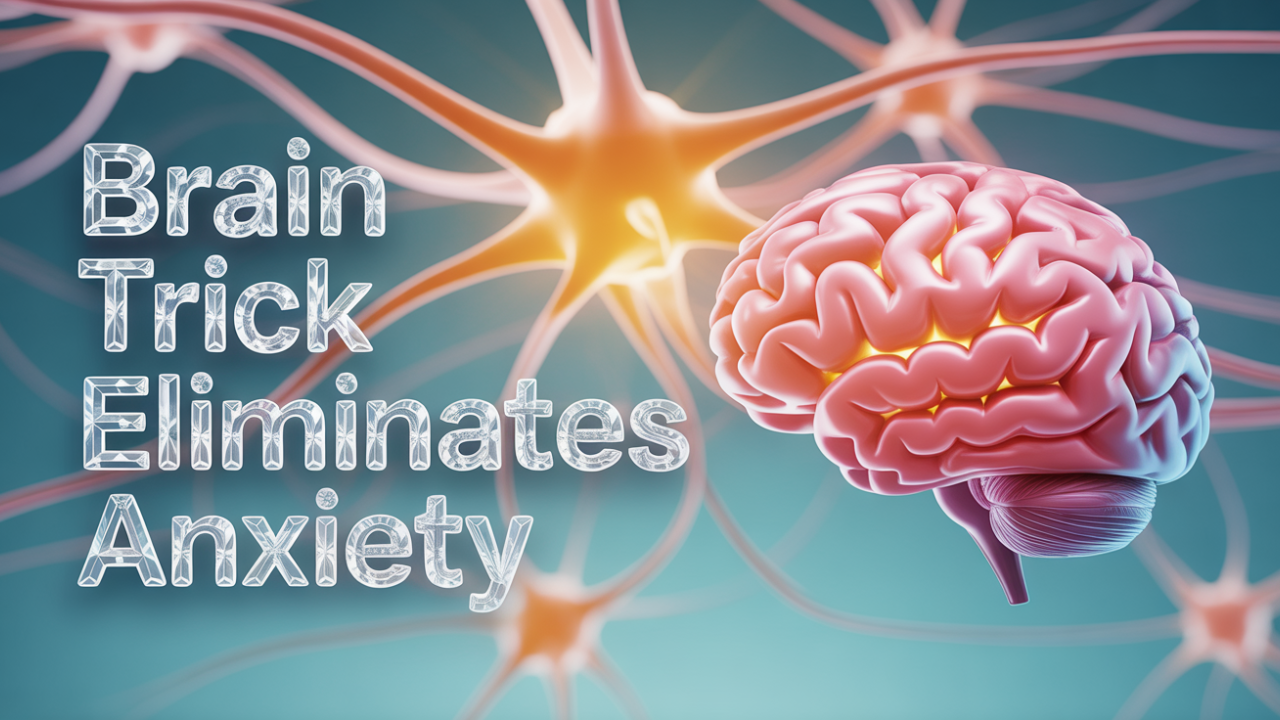Title: Neuroplasticity Techniques to Calm Anxiety
—
### **Intro & Hook**
Does it ever feel like your own brain is working against you? Like you’re trapped in a never-ending loop of worry, and you just can’t find the ‘off’ switch. You know the feeling… that tightness in your chest, your heart racing, your thoughts spiraling until your own mind feels like a cage.
What if I told you that you have the power to physically rewire those anxious circuits in your brain? That this isn’t a permanent state, but a pattern that you can actually change. In this video, I’m going to show you simple, science-backed exercises that can reshape your brain, help you build a foundation of calm, and let you take back control. We’re not just talking about “coping” with anxiety; we’re talking about fundamentally changing your brain’s response to it. And this isn’t wishful thinking—it’s the science of neuroplasticity.
### **Section 1: The Anxious Brain – Why You Feel Trapped**
So, to change a pattern, you first have to understand it. Let’s talk about why you feel so stuck. Anxiety isn’t just a feeling; it’s a physical process—a survival mechanism that’s stuck in overdrive.
At the center of it all is a tiny, almond-shaped part of your brain called the amygdala. Think of your amygdala as your brain’s hyper-sensitive smoke alarm. Its job is to scan for danger, and when it senses a threat, it pulls the alarm, triggering the fight-or-flight response. Your heart pounds, your breathing gets shallow, your muscles tense up… your body is getting ready to fight a predator, even if the “predator” is just a thought.
This system is brilliant if you’re, say, being chased by a bear. But what happens when the “threat” is a looming deadline, a tough conversation, or just a vague worry about the future? Your amygdala can’t always tell the difference. It just screams, “DANGER!”
Now, here’s where the trap gets set. The prefrontal cortex, the part of your brain right behind your forehead, is supposed to be the calm, rational manager. It’s in charge of logical thinking and emotional regulation. Its job is to hear the amygdala’s alarm and say, “Okay, thanks for the heads-up, but this is just an email, not a tiger. We can stand down.”
In an anxious brain, that communication system breaks down. Because of chronic stress or past events, the amygdala becomes overactive and jumpy. It starts seeing threats everywhere. At the same time, the connection to the rational prefrontal cortex gets weaker. It’s like the calm manager has been put on mute, and a panicky intern is running the whole show. Your body gets flooded with stress hormones, but with nowhere to run, you’re just left feeling revved up and stuck.
Have you ever found yourself replaying a negative event for hours? Or you start with one tiny worry, and before you know it, you’ve spiraled into a worst-case scenario? That’s the anxiety loop in action. Every time you have an anxious thought and you react with fear, you’re reinforcing a neural pathway. It’s like walking the same path in a forest. At first, it’s a faint trail. But the more you walk it, the deeper and wider that path gets, until it’s a well-worn road.
Eventually, this anxious path becomes your brain’s default. It’s literally easier for your brain to slide into worry than to find a new way toward calm. This is why anxiety can feel so automatic and relentless. You feel trapped because, neurologically, you *are* stuck in a loop. But the most important thing to know is this: that loop isn’t permanent.
### **Section 2: The Hope of Neuroplasticity – Your Brain’s Superpower**
So, how do we break free? This is where we get to the most hopeful idea in all of neuroscience: neuroplasticity. For a long time, scientists thought the adult brain was basically fixed. That by your early twenties, the wiring was set in stone. We now know that’s completely wrong.
Neuroplasticity is the brain’s incredible ability to change, reorganize, and form new connections throughout your entire life, based on your experiences, thoughts, and actions. It’s how we learn and create memories, and it’s the key to unwiring anxiety.
Think of your brain as a giant power grid with billions of pathways. When you repeatedly have a thought or do an action, the electricity flows down the same paths, making them stronger and faster. The old saying in neuroscience is, “Neurons that fire together, wire together.” This is how habits are formed—both good and bad. Your anxiety is just a strong, well-established network of neurons that have fired and wired together, over and over again.
But here’s the beautiful part: you can intentionally create *new* pathways. You can build new roads that lead to calm. Think of it like a muscle. The more you work out the “anxiety muscle,” the stronger it gets. But you can choose to start exercising a “calm muscle” instead. At first, it feels awkward and difficult. The old anxious pathways will try to pull you back. But if you stick with it, the new calm pathways get stronger, more dominant, and more automatic. And the old anxious paths? Through disuse, they start to weaken and fade.
You’re not just managing symptoms; you’re physically changing your brain’s structure to be less anxious by default. This isn’t a metaphor; it’s biology. Studies show that practices like meditation can physically increase gray matter in the prefrontal cortex—your brain’s command center—and shrink it in the amygdala—the fear center.
You can be the architect of your own mind. You can actively heal yourself by giving your brain new instructions. It takes intention and it takes practice, but the ability to change is built right into your biology. So, let’s get practical. How do we actually do it?
### **Section 3: Technique 1 – Mindfulness: Paying Attention on Purpose**
When you hear “mindfulness” or “meditation,” you might picture someone sitting in a painful yoga pose, trying to force their mind to go completely blank. That’s a huge misconception, and it makes the whole thing feel impossible.
Mindfulness isn’t about stopping your thoughts; it’s about changing your *relationship* with them.
At its heart, mindfulness is just the practice of paying attention to the present moment, on purpose, with a sense of curiosity, not judgment. It’s about becoming an observer of your inner world—your thoughts, feelings, and body—without getting swept away by the drama.
So how does this actually change your brain? Remember that anxiety loop—the overactive amygdala and the sidelined prefrontal cortex? Mindfulness directly targets and reverses this exact pattern. When you practice mindfulness, you’re strengthening your prefrontal cortex, training your “brain’s manager” to be more focused and effective. At the same time, studies show that a consistent mindfulness practice can actually calm down the amygdala. You’re teaching your brain that it doesn’t need to hit the panic button for every single thought.
Let’s make this real.
**Sub-section 3a: Mindful Breathing**
The simplest way in is to focus on your breath. Your breath is always with you, and it’s a powerful anchor to the present moment.
Here’s how to do it. You can do this right now. Find a comfortable spot, either sitting with your feet on the floor or lying down. Gently close your eyes, or just lower your gaze. Now, just bring your attention to the feeling of your breath. Don’t try to change it. Just notice it.
Notice the air entering your nostrils. Is it cool? Notice your chest and belly rising on the inhale… and falling on the exhale. Your only job for the next minute is to follow the full journey of one breath, from the very beginning of the inhale to the very end of the exhale.
Now, your mind *will* wander. That’s not a failure; it’s just what minds do. You’ll start thinking about your to-do list, or something someone said yesterday. The moment you notice your mind has wandered… congratulations, you just did it. The practice is in the *noticing*.
When you notice you’ve drifted, just gently say to yourself, “thinking,” and then guide your attention right back to your breath. That’s it. That’s the whole exercise. Every time you guide your wandering mind back, it’s like doing a bicep curl for your prefrontal cortex. You’re strengthening your ability to choose what you pay attention to, and breaking the habit of getting yanked around by every anxious thought. Even three to five minutes a day can make a huge difference.
**Sub-section 3b: The Body Scan**
Anxiety doesn’t just live in your head; it lives in your body. It shows up as tense shoulders, a clenched jaw, or a knot in your stomach. Most of the time, we don’t even notice this tension until it’s screaming at us. The body scan is a powerful way to reconnect your mind and body and let go of that stored stress.
To start, lie down somewhere quiet and comfortable. Close your eyes and take a few deep breaths. Now, bring your attention all the way down to the toes on your left foot. Just notice what you feel there. Warmth? Tingling? The pressure of a sock? Maybe nothing? There’s no right or wrong answer. You’re just exploring with gentle curiosity.
Spend about 30 seconds there, then slowly move your attention up your body. The sole of your foot, your ankle, your shin, your knee. Take your time with each part, just noticing whatever sensations are there without judging them.
Continue this up through your legs, your hips, your stomach. Move your awareness up into your chest and across your shoulders—a place where so many of us hold tension. Just notice it. Don’t try to force it to relax. Then, move your attention down your arms and into your fingertips.
Finally, bring your awareness to your neck, your jaw, your face, and all the way to the top of your head. When you’re done, just take a moment to feel your body as a whole, breathing.
What you’re doing is training your brain to notice sensations without reacting with fear. This builds incredible resilience. When you can feel tightness in your chest and just observe it without panicking, you rob anxiety of its power.
### **Section 4: Technique 2 – Cognitive Restructuring: Rewriting Your Inner Script**
If mindfulness is about changing your relationship *to* your thoughts, cognitive restructuring is about changing the thoughts themselves. It’s a core technique in Cognitive Behavioral Therapy (CBT) and it’s incredibly effective. The idea is simple: our thoughts create our feelings. It’s not the situation that causes anxiety, but our *interpretation* of it.
For example, you text a friend and they don’t reply for a few hours.
Anxious thought: “They’re mad at me. I must have said something wrong. Our friendship is over.” That thought leads straight to anxiety and insecurity.
Balanced thought: “They’re probably just busy. They’ll get back to me when they can.” That thought leads to a calm, neutral feeling.
Same situation, totally different emotional outcome. Anxious brains have a bad habit of automatically jumping to those negative, worst-case-scenario thoughts. Cognitive restructuring is how we learn to catch, challenge, and replace them with more realistic ones. This isn’t about “toxic positivity” or pretending everything’s fine. It’s about being accurate.
Let’s break it down into four steps.
**Step 1: Identify the Negative Thought**
First, you just have to notice your automatic negative thoughts. A great way to do this is to keep a small notebook. Whenever you feel that jolt of anxiety, write down the situation and the exact thought running through your mind.
* Situation: My boss scheduled a “quick chat.”
* Automatic Thought: “I’m in trouble. I’m getting fired.”
* Situation: I have a presentation next week.
* Automatic Thought: “I’m going to bomb. Everyone will think I’m an idiot.”
Getting it out of your head and onto paper is a game-changer. It separates you from the thought and lets you look at it more objectively.
**Step 2: Challenge the Negative Thought**
Now, you become a detective. Put that thought on trial and look for the evidence. Ask yourself some hard questions.
* Is this thought 100% true?
* What’s the evidence *for* this thought? And what’s the evidence *against* it?
* Am I jumping to the worst possible conclusion? (That’s a cognitive distortion called catastrophizing).
* What would I tell a friend if they came to me with this exact worry? (We’re always kinder to our friends).
Let’s go back to the boss example.
* Thought: “I’m getting fired.”
* Challenge: “What’s the evidence? The meeting was scheduled suddenly. That’s it. What’s the evidence against it? My last review was good. We have a decent relationship. A ‘quick chat’ could be about literally anything.”
**Step 3: Replace the Negative Thought with a Balanced One**
Next, you create a new, more realistic statement. This is the thought you’ll use to build your new neural pathway.
* Old Thought: “I’m getting fired.”
* Balanced Thought: “I’m anxious because the meeting is unexpected. But there’s no real evidence I’m in trouble. It’s more likely a routine work thing. I can handle it, whatever it is.”
* Old Thought: “Everyone will think I’m an idiot.”
* Balanced Thought: “It’s normal to be nervous about this presentation, but I’ve prepared. Even if I stumble, it doesn’t make me an idiot. My goal is to share information, not to be perfect.”
**Step 4: Practice, Practice, Practice**
This feels weird at first. Your brain will want to slip back into its old habits. That’s okay. Just keep practicing. The more you catch, challenge, and change these thoughts, the weaker those old anxious pathways become, and the stronger your new, balanced pathways get. Over time, you’re literally reprogramming your mind.
### **CTA**
Now you have two powerful tools—mindfulness to create space from your thoughts, and cognitive restructuring to rewrite them. These are the building blocks for rewiring your brain. They aren’t quick fixes, but steady practices that create real, lasting change. If you’re finding this helpful and want to go even deeper with a structured program, I’ve created a guide called “The Calm Brain Course.” It has guided meditations, advanced techniques, and a full roadmap to help you build these skills. You can check that out at the link in the description below.
### **Section 5: Putting It All Together & Other Supportive Practices**
The real magic happens when you start weaving these techniques into your day. They work best together. This combination is often called Mindfulness-Based Cognitive Therapy, or MBCT, and it’s been proven to be incredibly effective.
Here’s how they work as a team:
Imagine you feel a sudden surge of panic. First, use **Mindfulness**. Instead of getting swept away, you pause. You take one mindful breath. You notice the racing heart, the tight chest—just as sensations. That pause creates a critical space between the trigger and your usual reaction.
In that space, you apply **Cognitive Restructuring**. You notice the thought: “Something is terribly wrong!” Now you can challenge it. “Is that true? Or is this just a wave of anxiety? I’ve felt this before, and it always passes. This is uncomfortable, but it’s not dangerous.” Then you replace it: “This is just my nervous system acting up. I can breathe through this. I am safe.”
This one-two punch is how you dismantle the anxiety loop in real-time. Mindfulness is the circuit breaker; cognitive restructuring is the rewiring.
To speed up the process, you can add a few other brain-changing habits:
1. **Gratitude:** Anxiety trains your brain to scan for threats. Gratitude does the opposite—it trains your brain to scan for the good. Each night, write down three specific things you’re grateful for. The taste of your morning coffee, a nice text from a friend, the sun on your face. This simple act strengthens the pathways for positive emotion.
2. **Self-Talk:** Your brain is always listening to your inner monologue. If it’s constantly critical, you’re just fueling the anxiety. Practice replacing that negative self-talk with a more supportive script. Instead of, “I can’t handle this,” try, “I am capable, and I can take this one step at a time.”
3. **Physical Exercise:** Moving your body is one of the fastest ways to change your brain chemistry. Exercise boosts a protein called BDNF, which is basically “Miracle-Gro for the brain.” BDNF helps you grow new neurons and strengthens the connections between them, directly fueling your brain’s ability to change. Even a brisk 30-minute walk can make a huge difference.
### **Conclusion**
Feeling trapped by anxiety can make you feel so alone. It can feel like you’re at war with your own mind. But the science of neuroplasticity gives us an empowering truth: your brain isn’t fixed. It is constantly changing, and you can guide that change.
You’re not broken. You’re not doomed to a life of worry. Those anxious loops are learned pathways, and what has been learned can be unlearned. By practicing mindfulness, you learn to step back from your thoughts. By using cognitive restructuring, you learn to rewrite the scary stories your mind tells you. And when you support all this with things like gratitude and movement, you create a brain where calm can finally grow.
This is a practice, not a performance. It’s about consistency, not perfection. Every time you choose a mindful breath over a spiral, every time you challenge a negative thought, you are laying down a new track. You’re strengthening a new connection. You are literally rewiring your brain for peace. You have the tools. The power to change your mind has been inside you all along.





